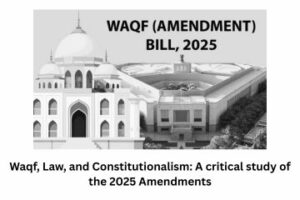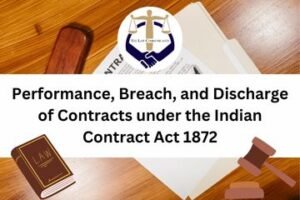Environmental Clearances Procedure
Written by: Gogula Madhavi Lakshmi
INTRODUCTION
India has a lot of potential of attracting international business but the ease of doing business needs to be improved. India presently stands at 142nd out of 189 in world banks’ latest ranking, the government has taken several steps to case the business. However, no concrete steps have been taken by the ministry of environment and forest in the environment, and forest clearance has been online. With the positive mindset under the make-in-India initiative, environmental clearance needs to be made easier.
In Singapore, there is a code of practice for pollution control SS 593: 2013 which specifies the recommended pollution control requirements and good practices to safe grand clean air, clean land clean water, and quality of the living environment. This code also includes siting requirements of various types of developments, management of hazardous substances and toxic industrial wastes, and land contamination and remediation. The process of obtaining environmental clearance in Singapore is not very long, unlike in India.
CII- KPMG case of doing business in India 2014 report states very clearly that obtaining approvals like environmental clearance, land procurement, construction-related permits and NOCs is a major obstacle in starting a business ‘the world banks doing business 2014 report states that India ranks 179 among 189 countries on the case of starting a business, with less desirable performance in the batch of BRICKS and other developing Asian countries, approvals related to environmental clearance, land procurement, construction permits, industrial safety permits, and power connection are top five obstacles in starting a business in India. As per the survey made by CII- KPMG about 50% of the respondents have highlighted major challenges in obtaining environmental clearances. More than one-third of the respondent rated approvals as the major obstacle in starting a business.
ENVIRONMENTAL LAW AND ENVIRONMENTAL CLEARANCE IN INDIA
Environmental law is a body of law that is a complex system of statutes, common law treaties conventions regulations, and policy that seek to protect the natural environment which may be impacted or affected or endangered by human activities. Thus, environmental law refers to rules and regulations governing human conduct likely to affect the environment. It reflects the legislative measures, and the administrative and judicial structures to protect the environment. However, it is difficult to define precisely the boundaries of environmental law in the same way as we define, say the law of contract.
In India Environmental clearance of a project has to be obtained either from State Government and /or from the Central Government. The basic objective behind the environmental clearance is to ensure the least damage to the natural resources and incorporate suitable remedial measures right at the stage of project formulation.
The Environmental Impact Assessment (EIA) notification issued by the Ministry of Environment & Forest (MoEF) includes the details of the procedure for obtaining Environmental Clearance and public hearing for decision making. This EIA notification is valid for both Government as well as the Public sector/Private sector for mega projects undertaken by them. The potential impacts of proposed projects, plan programs, or legislative actions relative to the physical-chemical, biological, cultural, and socio-economic components of the total environment.
The Environment (Protection) Act, 1986 authorizes the central government to protect and improve environmental quality, control and reduce pollution from all sources, and prohibit or restrict the setting and /or operation of any industrial facility on environmental grounds.
The Environment (Protection) Rules 1986 lay down procedures for setting standards of emission or discharge of environmental pollutants. The Act empowers the Government to take all necessary measures to protect control and abate environmental pollution.
The Act identifies the MoEF, Government of India as the apex nodal agency to deal with environmental problems of the nation so that an integrated and holistic policy can be implemented with regard to the environment.
The scope of this Act is very broad covering water, Air, Land and human beings and other living creatures.
The main functions of MoEF are:
- Coordination of the activities of various central and state authorities established under the Previous Acts;
- Laying down emission/ effluent standard for various industrial activities;
- Powers to get information about the industrial process and to inspect the plant, premises, records, and other necessary materials including seizure of the documents;
- Giving direction for closure, prohibition, or regulation of industrial processes as necessary and
- Stoppage or regulation of the supply of water and electricity or any other services to industries violating pollution standards
Requirements of prior Environmental Clearance (EC)
The following projects or activities shall require prior environmental clearance from the concerned regulatory authority, which shall be hereinafter referred to as the Central Government in the Ministry of Environment and Forests for matters falling under Category ‘A’ in the Schedule and at the State level, the State Environment Impact Assessment Authority (SEIAA) for matters falling under Category ‘B’ in the said Schedule, before any construction work, or preparation of land is started on the project or activity: by the project management, except for securing the land,
- All new projects or activities listed in the Schedule to this Notification; and
- Expansion and modernization of existing projects or activities listed in the Schedule to this Notification with the addition of capacity beyond the limits specified for the concerned sector, that is, projects or activities that cross the threshold limits given in the Schedule, after expansion or modernization.
- The project proponent identifies the location of the proposed plant after ensuring compliance with existing siting guidelines. If the project site does not agree with the siting guideline, the proponent has to identify other alternative sites for the project
- The project proponent then assesses if the proposed activity/project falls under the purview of environmental clearance. If it is mentioned in the schedule of the notification, the proponent conducts an EIA study either directly or through a consultant. If the project falls in the B category, the project goes to the state government for clearance which further categorizes into B1 and B2 projects. B2 projects do not require the preparation of EIA reports.
- After the EIA report is ready, the investor approaches the concerned State Pollution Control Board (SPCB) and the State Forest Department (if the location involves the use of forestland). The SPCB evaluates and assesses the quantity and quality of effluents likely to be generated by the proposed unit as well as the efficacy of the control measures proposed by the investor to meet the prescribed standards. If the SPCB is satisfied that the proposed unit will meet all the prescribed effluent and emissions standards, it issues consent to establish (popularly known as NOC), which is valid for 15 years.
- The public hearing is a mandatory step in the process of environmental clearance for certain developmental projects. This provides a legal space for people of an area to come face-to-face with the project proponent and the government and express their concerns.
The process of the public hearing is conducted prior to the issue of NOC from SPCB. The District Collector is the chairperson of the public hearing committee. Other members of the committee include the official from the district development body, SPCB, Department of Environment and Forest, Taluka and Gram Panchayat representative, and senior citizen of the district, etc. The hearing committee hears the objections/suggestions from the public and after inserting certain clauses it is passed on to the next stage of approval (Ministry of Forest and Environment).
- The project proponent submits an application for environmental clearance with the MoEF if it falls under Project A category or the state government if it falls under project B category. The application form is submitted with the EIA report, EMP, details of the public hearing, and NOC granted by the state regulators.
- Environmental appraisal: The documents submitted by an investor are first scrutinized by a multi-disciplinary staff functioning in the Ministry of Environment and Forests who may also undertake site visits wherever required, interact with the investors and hold consultations with experts on specific issues as and when necessary.
- After this preliminary scrutiny, the proposals are placed before specially constituted committees of experts whose composition is specified in the EIA Notification. Such committees, known as Environmental Appraisal Committees have been constituted for each sector such as River Valley, Industries, Mining, etc. and these committees meet regularly to appraise the proposals received in the Ministry. In the case of certain very special/controversial projects, which have aroused considerable public interest, the committee may also decide to arrange for public hearings on those projects to ensure public participation in developmental decisions. Announcements for such a public hearing shall be made at least 30 days before through newspapers. On the basis of the exercise described in the foregoing paragraphs, the Appraisal Committees make their recommendations for approval or rejection of particular projects. The recommendations of the Committees are then processed in the Ministry of Environment and Forests for approval or rejection.
Issues of clearance or rejection letter: When a project requires both environmental clearance as well as approval under the Forest (Conservation) Act, 1980. Proposals for both are required to be given simultaneously to the concerned divisions of the ministry. The processing is done simultaneously for clearance/rejection, although separate letters may be issued. If the project does not involve the diversion of forest land, the case is processed only for environmental clearance.
Once all the requisite documents and data from the project authorities are received and public hearings (where required) have been held, assessment and evaluation of the project from the environment angle is completed within 90 days and the decision of the ministry shall be conveyed within 30 days thereafter. The clearance granted shall be valid for a period of five years for commencements of the construction or operation of the project.
Industrial projects located in any of the following notified ecologically fragile/sensitive areas would require environmental clearance irrespective of the type of project:
- Religious and historic places
- Archaeological monuments
- Scenic areas
- Hill resorts
- Beach resorts
- Coastal areas rich in mangroves, corals, breeding grounds of specific specie Estuaries
- Gulf areas
- Biosphere reserves
- National parks and sanctuaries
- National lakes and swamps
- Seismic zones
- Tribal settlements
- Areas of scientific and geological interest
- Defense installations, especially those of security importance and sensitivity to pollution
- Border areas (international)
- Airports
The composition of MoEF’s expert committees that grant final clearance, has also been criticized (see box: Hidebound). Clearance is issued subject to conditions the project proponent has to meet, and to implementing an Environment Management Plan (emp). MoEF is supposed to monitor both. The proponent has to submit half-yearly progress reports to MoEF. But in reality, such monitoring hardly happens.
An example of this is the Teesta v hydroelectric project in Sikkim. “By April 2005 this project had already violated a number of conditions that were laid out at the time of project clearance,” says Ritwick Dutta, a Supreme Court advocate. The half-yearly reports NHPC, the project proponent, submitted say the company’s meeting most of the conditions while building the project. But the reality is completely different: NHPC’s project violations include deviation from the environmental management plan in sitting project components, additional non-forest land leased for project work without environmental clearance, and muck disposal on undiverted forest land.
No redressal For individuals or groups unsatisfied with the clearance, a redressal mechanism is available in the form of the National Environment Appellate Authority (NEAA), which was formed in 1997 to deal with grievances related to environmental clearance. The authority comprises a chairperson (a retired chief justice of the high court or a retired judge of the Supreme Court), a vice-chairperson (a secretary-level officer), and three technical members. But for the last five years, this authority has had no head. There have been no technical members for the last two years. The term of vice-chair ended in July leaving NEAA without any chair or members.
CONCLUSION
The key finding of this approval process undoubtedly states that India needs to seriously think about the time allotted to each process for obtaining environmental clearance if India desires to attract Foreign Direct Investment (FDI). Though the philosophy of the Environmental Impact Assessment is most essential to protect the environment and keep a balance between the ecology and the economy, development, and pollution, it is necessary to revamp the time taking stages as it has become a major obstacle in starting a business in India. In the last couple of years administrative and bureaucratic issues that have come up have made it difficult for the local investors to invest. It is high time that India like Singapore and Hong Kong should protect the investors to boost up the Indian economy.
References
Recent Initiatives for ease of doing Business in India http://www.drishtiias.com/upsc-exam-gs-resources-Recent-INITI..
http://www.doingbusiness.org/reports/global-reports/doing-business-2015
Ease of Doing Business in India May 2014 http://www.doingbusiness.org/reports/global-reports/doing- business-2015
Ease of Doing Business Rankings: India at 142 out of 189 Countries Track.in
Doing Business, Singapore Style
http:/www.cato.org/publications/commentary/doing-business-singapore-style
Doing Business Singapore vs India
http://www.guidemesingapore.com/country-reports/india/doing-business-singapore-vs-india Doing Business in Singapore vs India http://www.mahesh.com/corporate/doing-business-in-singapore-vs-india
Doing Business still tough in India, Singapore the best: World Bank http://www.business-
standard.com/article/economy-policy/doing-business-still-tough-in-india-singapore-the-best-world-bank-112102402011_1.html
5Reasons Indian Start-Ups are Heading Singapore
http://www.business-standard.com/article/economy-policy/doing-business-still-tough-in-india-singapore-the best-world-bank-112102402011_1.html
Dealing with construction permits, Doing Business 2012 http://www.doingbusiness.org/reports/globalreports/doingbusiness2012Reports/English/D
Chapters/Dealing-with-construction-permits.pdf
Ease of doing business in India slips, India Realtime, The Wall Street Journal,
http://www.doingbusiness.org/reports/global-reports/doing-business
Environmental Impact Assessment http://envfor.nic.in/division/introduction-8
Environmental Law and Multi-Lateral Agreement- www.unep.org
Larry W. Canter, Environmental Impact Assessment, McGrew Hills, 2005
V C Patel, Environmental Impact Assessment for Construction Industry at Hazira, ME Dissertation submitted to Sardar Patel University guided by 2005.
Previous Posts
Right to form association or unions: Constitutional, legislative and judicial perspective
Right to get water: the recent development and constitutional framework
The International Criminal Court as a Court – An Evaluation
Victims of crime: Restoration and Legal care under Indian Criminal Jurisprudence




